Physical Address
304 North Cardinal St.
Dorchester Center, MA 02124
Transcatheter aortic valve replacement (TAVR) has become the default therapy for patients with aortic stenosis who, based on an expanding randomized evidence base, are at increased risk for surgery. TAVR procedures have now surpassed the number of surgical aortic valve replacements in the United States.
The most frequently used self-expanding bioprotheses—the CoreValve family of CoreValve Classic, Evolut-R, Evolut-34 mm, and Evolut-PRO—have specific design features of annular conformability; supra-annular valve location, resulting in lower gradients; and partial retrievability, allowing for optimal positioning of the bioprosthesis.
Computed tomographic imaging is an essential tool for self-expanding TAVR, allowing for oversizing relative to the perimeter-based annular dimensions as well as determining the safety of implantation with the assessment of sinus of Valsalva widths and coronary heights. These techniques have enabled a reduction in the rate of residual aortic valve regurgitation after implantation.
Compared with surgery, TAVR has lower rates of atrial fibrillation, bleeding complications, acute kidney injury, and stroke reduction in some series, but it also means higher rates of residual aortic regurgitation and pacemaker use. TAVR is associated with improved early functional recovery and quality of life.
Owing to the reduction in sheath size required for self-expanding TAVR, alternative access methods using direct aortic, subclavian, carotid, or transcaval approaches are rarely needed but can provide options for patients with limited iliofemoral access.
The use of self-expanding TAVR for failed surgical valves is particularly beneficial given the supra-annular design, which allows lower gradients than balloon-expandable TAVR for any given size of surgical valve. Care must be taken to avoid coronary occlusion in this setting.
Other indications for self-expanding TAVR include end-stage renal disease; low-gradient, low-output aortic stenosis; primary aortic regurgitation; and bicuspid aortic valve disease. TAVR appears promising in this subset of patients with the next generation of devices.
Complications associated with self-expanding TAVR are decreasing, particularly when lower-risk patients are treated. Conduction disturbances, although lower with contemporary designs, remain problematic for some patients.
Additional Nitinol-based TAVR devices—such at the Acurate Neo, Lotus Edge, and Portico—will soon be available for patients in the United States.
It has been less that a decade since the initial commercial introduction of transcatheter aortic valve replacement (TAVR) in the United States for patients with symptomatic aortic stenosis who are deemed unsuitable for surgery. Since the advent of percutaneous coronary intervention in 1977, no transcatheter therapy has transformed the management of patients with cardiovascular disease as profoundly as has TAVR. Based on an ever-increasing portfolio of well-designed and executed clinical studies demonstrating the value of TAVR over surgery, practice guidelines now support the use of TAVR for patients deemed at extreme or high risk for surgery (class I) by a multidisciplinary heart team as well as for patients deemed at intermediate risk for surgery (class IIa). Most recently, randomized trials of TAVR in patients at low risk for surgery now support this indication as well (NR1, NR2), and practice guidelines are expected to reflect this in their next iteration; their results will likely facilitate further paradigmatic shifts for physicians and patients who seek to determine the most appropriate method of aortic valve replacement.
Two general concepts of TAVR prostheses have been developed: the first facilitates transcatheter valve deployment by means of balloon expansion, using a plastically deformable metal frame; the second facilitates valve deployment using self-expanding or mechanically expanded Nitinol prostheses that provide constant outward force to secure the prosthesis without migration. Although both techniques have led to outstanding results and can be used safely in the majority of patients with severe aortic stenosis, there are differences between the two methods that may render one more appropriate than the other on the basis of clinical and anatomic parameters.
The purposes of this chapter are as follows: (1) to review the design of the CoreValve family of self-expanding TAVR devices; (2) to discuss the clinical results from the expansive array of clinical studies establishing the value of self-expanding TAVR devices; (3) to review the complications associated with self-expanding TAVR devices; and (4) to catalog the additional self-expanding bioprostheses that will be available for commercial use in the United States over the next several years.
Multiple iterations of the CoreValve transcatheter heart valve have been developed over the past decade to improve the performance of the self-expanding prosthesis. The first-generation CoreValve comprised a 25-Fr delivery catheter that housed a self-expanding Nitinol frame supporting a bovine pericardial valve. The second-generation 21-Fr delivery catheter used lower-profile porcine pericardial tissue and scalloped the inflow portion of the valve in order to provide better flow hemodynamics. The third-generation 18-Fr CoreValve transcatheter aortic valve achieved its lower profile by cutting the skirt and leaflet into six independent sections and sewing them onto the Nitinol frame. This valve design was approved by the Conformiteé Européenne (CE Mark) in March 2007 and by the U.S. Food and Drug Administration (FDA) for extreme-risk patients in January 2014; it was approved for high-risk patients in April 2014.
The basic design concepts of the CoreValve Classic transcatheter heart valve have been retained over successive generations. They include (1) a self-expanding Nitinol support frame with cells configured in a diamond cell design that anchors a trileaflet supra-annular porcine pericardial tissue valve ( Fig. 54.1 ); (2) an 18-Fr Accutrek delivery catheter that has evolved into a low-profile 14- to 16-Fr Enveo In Line sheath; and (3) a disposable loading system. The CoreValve Classic was available in the following sizes: 23 mm (annular diameter 18 to 20 mm), 26 mm (aortic annular diameter 20 to 23 mm), 29 mm (annular diameter 24 to 26 mm), and 31 mm (annular diameter 26 to 29 mm). The Nitinol frame has three levels of radial and hoop strength. The inflow portion exerts a high radial expansive force to secure the frame within the aortic annulus. The strength of this portion of the frame prevents annular recoil; allows the frame to partially conform to the noncircular shape of the aortic annulus, thus preventing frame migration; and minimizes the occurrence of paravalvular leaks. The “constrained” center portion of the frame has a high hoop strength, which resists size and shape deformation; this is critical, as this portion of the frame contains the supra-annular valve leaflets. The frame is concave at this location to avoid blocking the coronary ostium with the native valve and allows coronary cannulation after the implantation. The outflow portion of the frame exerts low radial forces and serves to orient the frame to the aorta parallel to flow through the valve. Porcine pericardium was selected due to its lower profile (compared with bovine pericardium) and its documented durability. The three leaflet elements are constructed with long commissures, similar to a “suspension bridge.” These distribute the aortic pressure load more uniformly to the valve leaflets and the commissural posts. An angled take-off of the posts further reduces stress and optimizes leaflet motion. The ability to maintain functionality in a nonround shape at the inflow is a critical feature of the self-expanding CoreValve system, as the constrained portion of the frame supporting the valve remains in a circular configuration.
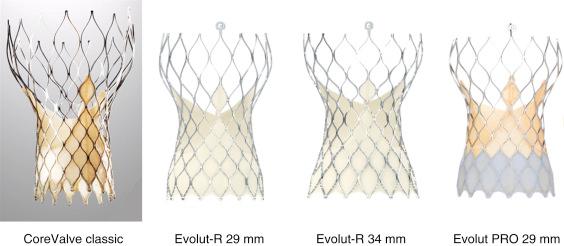
To further improve on the CoreValve Classic design, the fourth-generation Evolut-R self-expanding bioprosthesis includes a 14-Fr equivalent EnVeo R Deliver Catheter System, a modified Nitinol design at the annulus that optimizes radial expansive force, a longer porcine pericardial sealing skirt, and a Nitinol delivery catheter capsule that allows resheathing and recapture during deployment (see Fig. 54.1 ). The partially recapturable Evolut 34 mm allows treatment of annular diameters from 26 to 30 mm and is deliverable with a 16-Fr compatible Enveo delivery system ( Fig. 54.2 ). Finally, the Evolut-PRO leverages the same frame and skirt design as the Evolut-R but adds a thin pericardial wrap around the outside of the frame that decrease the degree of residual aortic regurgitation by increasing the surface area contact by 80% ( Fig. 54.3 ). The Evolut-PRO is delivered with a 16-Fr equivalent EnVeo Delivery catheter.
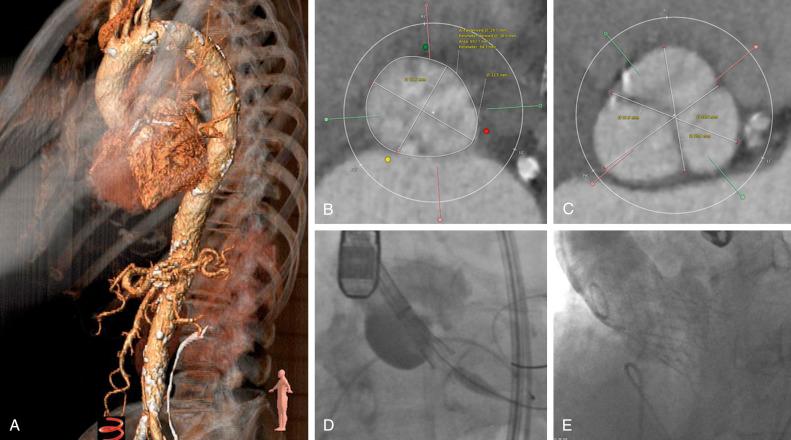
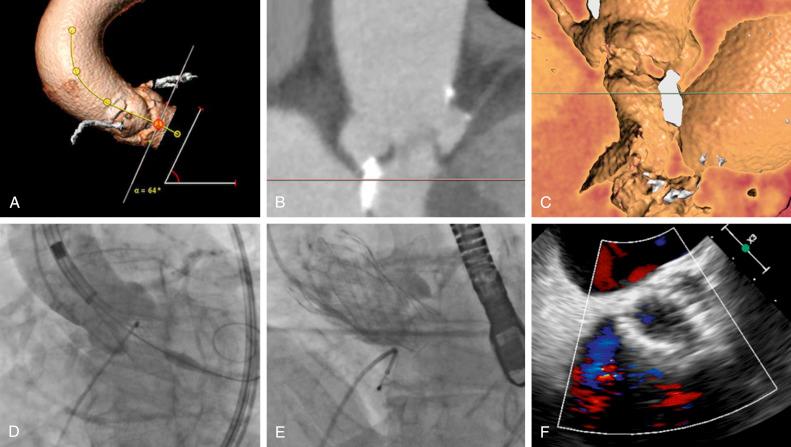
Multidetector computed tomographic angiography (CTA) is now the gold standard for transcatheter valve selection and is used to determine annular size and iliofemoral (IF) dimensions prior to the selection of the Evolut-R and Evolut-PRO for TAVR. End-systolic perimeter measurements of the basal annular place should be used for valve size selection to reduce the degree of paravalvular regurgitation after TAVR ( Fig. 54.4 ). In an analysis of patients enrolled in the CoreValve Clinical Trials and Continued Access Registries using the CoreValve Classic, higher device/artery ratios (DARs) were associated with lower rates of moderate or severe paravalvular aortic regurgitation (DAR ≤10%, 17.6%; DAR 10% to 15%, 9.9%; DAR 15% to 20%, 6.3%; and DAR >20%, 4.9%; P < .001). Importantly, there was no increase in complications associated with valve oversizing. The preprocedural CTA also permits measurement of the sinus of Valsalva (SOV) diameters and coronary heights prior to the procedure. In general, in order to prevent coronary occlusion during deployment, the average SOV width for the 23-mm Evolut-R or Evolut-PRO should be 25 mm or larger, the average SOV width for the 26-mm Evolut-R or Evolut-PRO should be 27 mm or larger, the average SOV width for the 29-mm Evolut-R or Evolut-PRO should be 29 mm or larger, and the average SOV width for the Evolut 34-mm should be 31 mm or larger. Coronary heights less than 10 mm above the aortic annulus should be approached with caution in order to avoid coronary occlusion from the Evolut skirt (14 to 15 mm in height) during deployment; lower valve implantation is sometimes required in this setting. Aortoventricular angles greater than 70 degrees should be avoided with the CoreValve device.
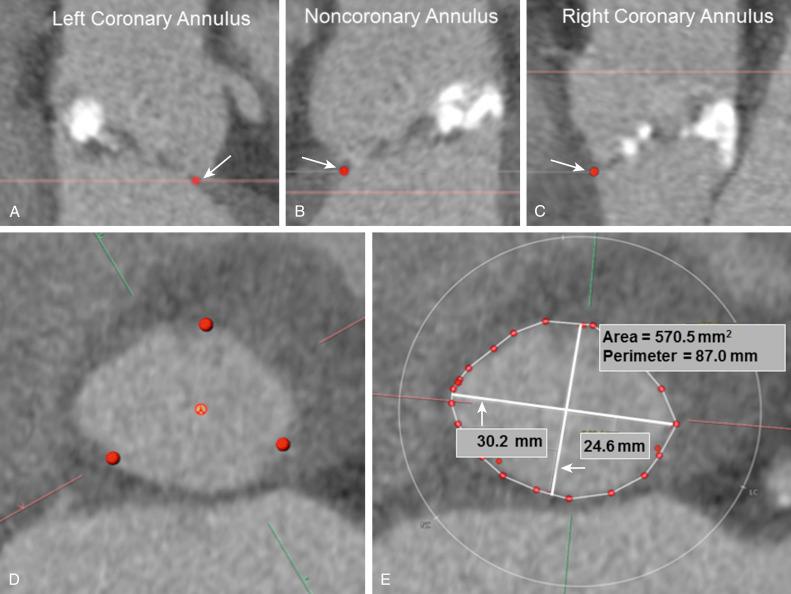
In most circumstances patient are pretreated with aspirin and clopidogrel (for those undergoing IF access only), although the incremental benefit of dual antiplatelet therapy (DAPT) has not been demonstrated. Depending on the patient’s clinical status and institutional preferences, either general anesthesia or conscious sedation can be used. A temporary 5-Fr pacing wire is positioned within the right ventricle for “fast” or “rapid” pacing during the procedure; in some cases, the TAVR wire has been used for direct left ventricular pacing. Arterial access is then obtained on the side contralateral to the planned 14- to 16-Fr sheath for the EvolutR (14-Fr), Evolut-R 34 mm, or Evolut-PRO (16-Fr) TAVR. Both angiographically guided and ultrasound-guided methods have been used for arterial puncture. Once access has been obtained, anticoagulation is administered to achieve an activated clotting time (ACT) equal to or greater than 250 seconds.
A 5- or 6-Fr pigtail catheter is advanced to the ascending aorta and its distal tip positioned in the noncoronary sinus; a long sheath may be use to stabilize the injection catheter. The gantry position is optimized to allow visualization of all three coronary sinuses in the same plane. An angiographic catheter is then advanced over a standard J-tip guidewire through the primary access sheath and advanced to the ascending aorta. The J-tip guidewire is exchanged for a 0.035-inch straight-tip guidewire, which is used to cross the aortic valve. Once the guidewire is across the aortic valve, the catheter is advanced into the ventricle and hemodynamics are obtained. A 0.035-inch preshaped guidewire (e.g., Confida or Safari preshaped wire) is advanced through the angiographic catheter and positioned in the apex of the left ventricle. Balloon valvuloplasty may then be performed using a balloon sized to the minor axis of the CTA and fast ventricular pacing at 180 beats/min, particularly in the presence of severe valvular calcification ( Fig. 54.5 ). Most commonly now, predilation is not performed and the Evolut-R or Evolut-PRO is advanced directly across the annulus.
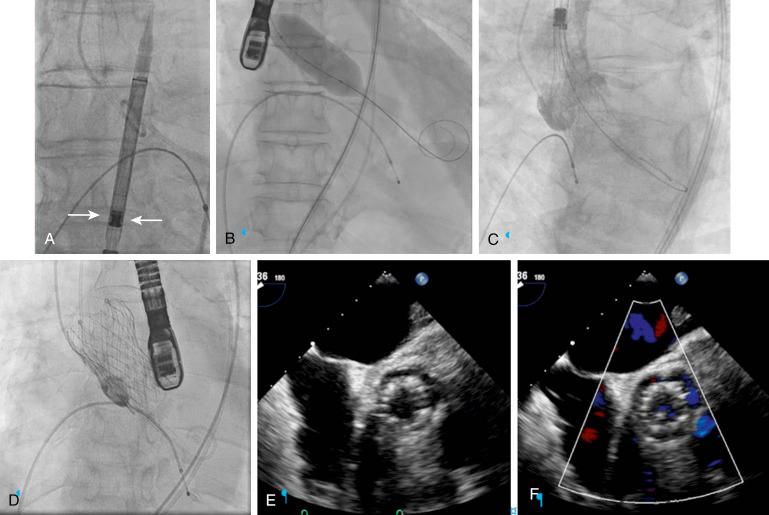
The Evolut-R or Evolut-PRO is then advanced over the 0.035-inch guidewire and positioned across the native valve. Aortography is used to identify the inferiormost aspect of the valvular plane in the noncoronary sinus. The Evolut bioprothesis is then positioned with the inflow portion within the aortic annulus (approximately 2 to 4 mm below the annulus). The 0.035-inch wire is used to stabilize the CoreValve along the greater curvature of the aorta, but excessive pressure on the wire in the left ventricular apex should be avoided. As the slow Evolut-R or Evolut-PRO deployment begins, “fast” pacing at 110 to 120 beats/min may be used to lower the intraventricular pressure and stabilize deployment. As the inflow aspect of the device begins to flare outward, aortography is performed sequentially and final positioning is obtained. Once the Evolut frame has been deployed, aortography is performed to assess the degree of residual stenosis within the frame and the degree of aortic regurgitation. Hemodynamics may now be assessed to ensure adequate separation of the left ventricular and aortic diastolic contours. Transesophageal or transthoracic echocardiography is performed to assess the degree of aortic regurgitation. Concordance of the angiographic, hemodynamics, and echocardiography are critical for the determination of the need for balloon postdilatation, which can be performed to expand the frame using the mean diameter of the annulus ( Fig. 54.6 ). After a satisfactory result has been achieved, the vascular sheath is removed and percutaneous or open closure is performed. In the event of conduction disturbances during the procedure, patient should be observed with temporary pacemaker placement in a cardiovascular intensive care unit (ICU) for for 24 to 48 hours and monitored for conduction system disturbance. The patient may be discharge 24 to 48 hours after the procedure.
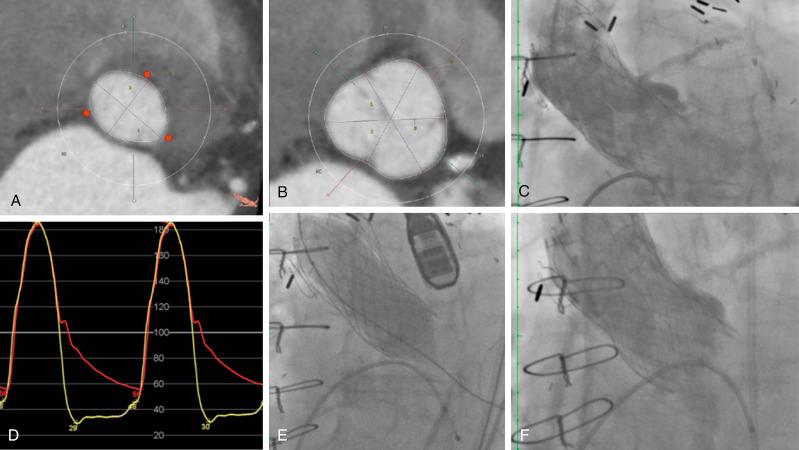
Selection of patients suitable for CoreValve TAVR is best facilitated using a multidisciplinary team (MDT) that includes cardiac surgeons, interventional cardiologists, imaging specialists, and geriatricians. The MDT generally reviews the clinical, anatomic, and vascular information for the individual patient and determines his or her suitability for CoreValve TAVR based on estimated surgical risk, which may include convention risk criteria (e.g., Society for Thoracic Surgery Predicted Risk of Mortality [STS PROM]) supplemented by the nontraditional risk factors of severe comorbidities, frailties, and disabilities).
Extreme-risk patients are those who have an expected mortality or irreversible comorbidities equal to or greater than 50% at 30 days with surgery. The CoreValve Extreme Risk Study was a prospective, multicenter, nonrandomized investigation that recruited 506 patients, of whom 489 underwent attempted treatment with the CoreValve transcatheter heart valve. The rate of all-cause mortality or major stroke at 12 months was 26.0% (versus 43.0% with the objective performance goal; P < .0001). Individual 30-day and 12-month events included all-cause mortality (8.4% and 24.3%, respectively) and major stroke (2.3% and 4.3%, respectively) ( Table 54.1 ). Procedural events at 30 days included life-threatening/disabling bleeding (12.7%), major vascular complications (8.2%), and need for permanent pacemaker placement (21.6%). The frequency of moderate or severe paravalvular aortic regurgitation appeared to improve from 30 days to 1 year due to further expansion of the self-expanding prosthesis over time. The rates of 2-year all-cause mortality, cardiovascular mortality, and major stroke were 36.6%, 26.2%, and 5.1%, respectively. Between 1 and 2 years, the incremental all-cause mortality, cardiovascular mortality, and major stroke rates were 12.3%, 7.9%, and 0.8%, respectively, illustrating the overall morbidity of the patients enrolled in the study. Multivariate predictors of all-cause mortality at 2 years included the presence of coronary artery disease, admission from an assisted living center, and an STS PROM greater than 15%. The frequency of moderate or severe paravalvular regurgitation was unchanged between the first and second years (4.3% at 1 year, 4.4% at 2 years).
| Aortic Regurgitation | |||||||||||
|---|---|---|---|---|---|---|---|---|---|---|---|
| Author | No. of Pts | Valve | Risk | Age, Years | STS, % | Death, % |
All Stroke, % | ≤Trace, % |
Mild, % | Mod, % | PPM, % |
| Popma et al. | 489 | CoreValve | Extreme | 83.2 ± 8.7 | 10.3 ± 5.5 | 9.8 | All: 4.0 Major, 1.9 |
41.8 | 43.0 | 15.3 | 24.6 |
| Reardon et al. | 150 | CoreValve | Extreme—Alternative access | 81.8 ± 8.2 | 10.1 ± 5.6 | 9.5 | All: 5.4 Major: 3.0 |
33.6 | 31.0 | 7.0 | 18.2 |
| Adams et al. | 394 | CoreValve | High risk | 83.2 ± 7.1 | 7.31 ± 3.0 | All: 4.5 Disabling 1.2 |
54.9 | 36.6 | 7.7 | 19.8 | |
| Reardon et al. | 864 | CoreValve, Evolut | Intermediate | 79.9 ± 6.2 | 4.4 ± 1.5 | 2.8 | All: 3.4 Disabling: 2.2 |
35.7 | 35.9 | 3.2 | 25.9 |
| Thyregod et al. | 145 | CoreValve | Low | 79.2 ± 4.9 | 2.9 ± 1.6 | 2.1 | All: 1.4 | 23.4 | 61.3 | 14.5 | 34.1 |
| Barbanti et al. | 10,822 | Sapien 3: 5423, 45.9 Lotus: 3007, 25.4 Evolut-R: 1603, 13.6 Acurate: 1314, 11.1 Jena Valve: 345, 2.9 Portico: 130, 1.1 |
Variable | 82.1 (81.4–82.9) | NR | 2.2 | All: 2.6 Disabling: 0.9 |
NR | NR | 1.6 | 16.2 |
| Bagur et al. | 20 | Symetic Acurate | Intermediate | 82.7 ± 7 | 4.7 ± 2.3 | 0 | All: 0 | 75 | 25 | 0 | 5.3 |
| Mollmann et al. | 89 | First-in-Man Acurate Neo |
High risk | 83.7 ± 4.4 | 6.8 ± 4.1 | 3.4 | Major: 2.2 | 95.1 | 4.9 | 11.5 | |
| Kim et al. | 1000 | Acurate | Variable | 81.1. ± 5.2 | 6.6 ± 7.5 | 1.5 | Disabling: 2.3 | 50.4 | 46.0 | 3.4 | 9.9 |
| Husser et al. | 622 | Sapien 3 | Variable | 81 ± 6 | NR | 1.9 | 2.4 | NR | NR | 1.9 | 15.5 |
| 311 | Accurate | 81 ± 6 | NR | 2.3 | 1.9 | NR | NR | 4.8 | 9.9 | ||
| Jatene et al. | 49 | Accurate | Variable | 82.4 ± 5.4 | 6.1 ± 2.8 | 4 | 0 | NR | NR | 4 | 6 |
| 56 | CoreValve | 82.3 ± 7.7 | 5.6 ± 3.3 | 11 | 4 | NR | NR | 12 | 25 | ||
| 67 | Sapien XT | 83.1 ± 6.3 | 6.7 ± 4.9 | 4 | 2 | NR | NR | 4 | 11 | ||
| Popma et al. | 1468 | CoreValve, Evolut R, or Evolut PRO | Low | 74 +/- 5.9 | 1.9% + /-0.7% | 0.5% | All: 3.4% Disabling: 0.7% |
60.3% | 36.1% | 3.5% | 17.4% |
High-risk patients are those who have a greater than 10% risk of 30-day mortality with surgery. In the CoreValve High Risk pivotal trial, 795 patients were randomized to CoreValve TAVR or surgical aortic valve replacement (SAVR) at 45 high-quality surgical centers in the United States. The rate of death from any cause at 1 year was significantly lower in the TAVR group than in the SAVR group (14.2% vs. 19.1%), with an absolute reduction in risk of 4.9% (upper boundary of the 95% confidence interval [CI], −0.4; P < .001 for noninferiority; P = .04 for superiority). Although the mortality benefit with TAVR over SAVR was maintained at 2 years, mortality rates at 5 years were not different in the two groups (55.3% for TAVR and 55.4% for SAVR) ( Fig. 54.7 ). Major stroke rates were 12.3% for TAVR and 13.2% for SAVR. Aortic regurgitation remained more frequent in patients treated with CoreValve compared with SAVR at 5 years ( Fig. 54.8 ). Nevertheless the hemodynamic valve performance remained superior for TAVR at 5 years (mean aortic valve gradient: 7.1 ± 3.6 mm Hg for TAVR and 10.9 ± 5.7 mm Hg for SAVR) ( Fig. 54.9 ), and no clinically significant valve thromboses were observed. Freedom from severe structural valve deterioration was 99.2% for TAVR and 98.3% for SAVR ( P = .32); freedom from valve reintervention was 97.0% for TAVR and 98.9% for SAVR ( P = .04).
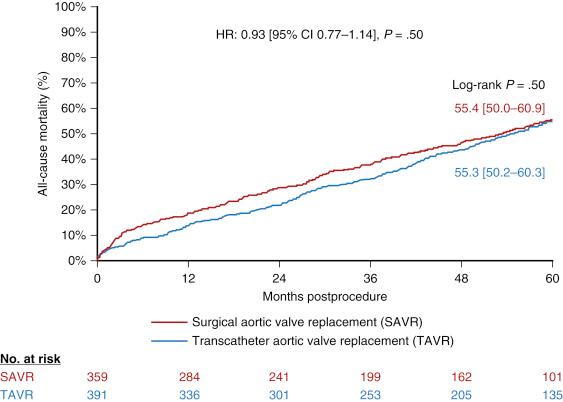

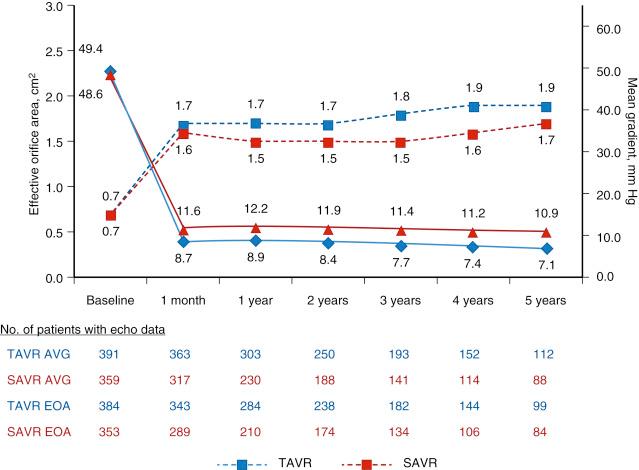
The CoreValve High Risk Clinical Trial also provided the first glimpse into the complication tradeoffs that occurred with TAVR and SAVR. Within 0 to 3 days, the major vascular complication rate was significantly higher with TAVR than with SAVR ( P = .003), whereas life-threatening or disabling bleeding ( P < .001), encephalopathy ( P = .02), atrial fibrillation ( P < .001), and acute kidney injury ( P < .001) were significantly higher with SAVR. Procedural complications unique to TAVR included coronary occlusion in 0.5% of patients and TAVR dislodgements in 2.8% of patients. Procedural complications unique to SAVR included aortic dissection in 0.8% of patients and injury to other heart structures in 2.0% of patients.
The difference in the mortality rate between TAVR and SAVR was evident only during the recovery period (31 to 120 days); 15 patients undergoing TAVR and 27 patients undergoing SAVR died during this period. This mortality difference was largely driven by higher rates of technical failure, surgical complications, and lack of recovery in the 31 to 120 days following surgery, in contrast to deaths between 0 and 30 days, where the causes of death were more technical failures in the TAVR group and lack of recovery in the SAVR group. It is apparent that the incremental mortality benefit of TAVR over SAVR is most profound in frail and disabled patients.
Moderate- (or intermediate-) risk patients are those who have an estimated surgical risk greater than 3% to 10%. In the Surgical Replacement and Transcatheter Aortic Valve Implantation (SURTAVI) randomized study of 1746 patients who were deemed at intermediate risk for surgery, the estimated incidence of the primary end point using Bayesian analysis was 12.6% in the TAVR group and 14.0% in the SAVR group; posterior probability of noninferiority was greater than 0.999. This novel approach provided an interim analysis of the study before all patients had reached their 24-month end point based on simulations of the estimation of the posterior probability of a credible estimate of expected event rates ( Fig. 54.10 ). SAVR was associated with higher rates of acute kidney injury, atrial fibrillation, and transfusion requirements, whereas TAVR had higher rates of residual aortic regurgitation and need for pacemaker implantation. TAVR resulted in lower mean gradients and larger aortic valve areas as compared with SAVR. Structural valve deterioration at 24 months did not occur in either group.
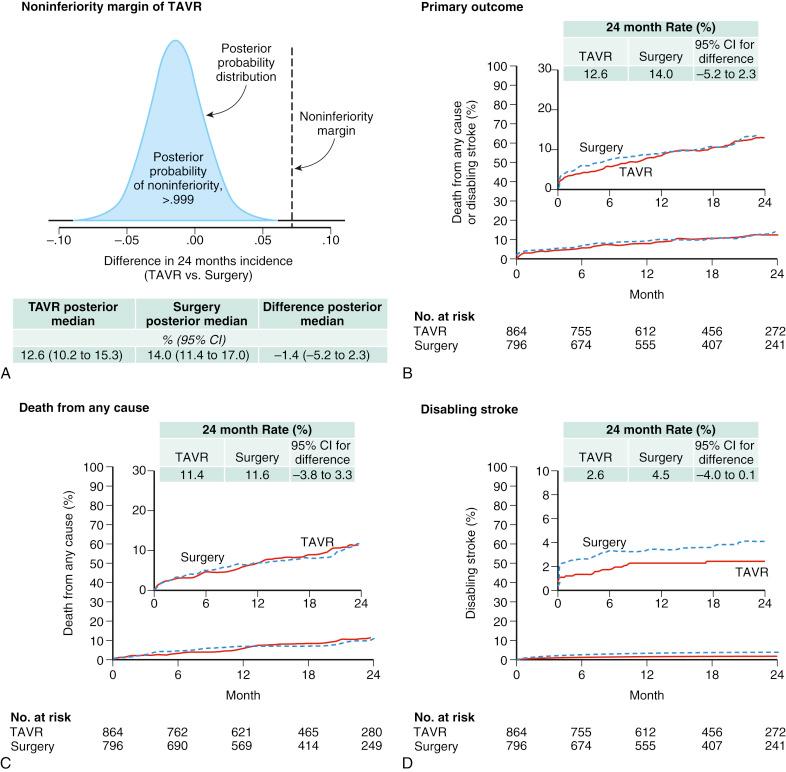
The Nordic Aortic Valve Intervention Trial (NOTION), a randomized clinical trial, compared TAVR with SAVR in an all-comers patient cohort. A total of 280 patients 70 years of age or older with severe aortic valve stenosis and no significant coronary artery disease were randomized 1:1 to TAVR using a self-expanding bioprosthesis or SAVR ; the mean age was 79.1 years and 81.8% of patients were deemed to be at low risk. The primary end point— death, stroke, or myocardial infarction within 1 year—was similar in the two groups (13.1% in TAVR vs. 16.3% in SAVR patients; P = .43 for superiority). Compared with SAVR patients, TAVR patients had more conduction abnormalities requiring pacemaker implantation, larger improvements in effective orifice area, more total aortic valve regurgitation, and higher New York Heart Association (NYHA) functional class at 1 year. Surgery patients had more major or life-threatening bleeding, cardiogenic shock, acute kidney injury (stage II or III), and new-onset or worsening atrial fibrillation at 30 days than did TAVR patients. Two-year results from the NOTION trial demonstrate the continuing safety and effectiveness of TAVR in lower-risk patients.
The Evolut Low Risk Trial was a randomized non-inferiority trial in which TAVR with a self-expanding bioprosthesis was compared to SAVR in patients who were at low surgical risk, defined as a predicted surgical mortality of no greater than 3% at 30 days. A total of 1468 patients were randomized to TAVR with a self-expanding bioprosthesis or SAVR in 86 centers worldwide. The primary endpoint, a composite of death or disabling stroke, was observed less frequently in the TAVR arm (5.3%) than the SAVR arm (6.7%) with a Bayesian analysis yielding a posterior probability of noninferiority of >0.999. The TAVR arm, compared to the SAVR arm, also demonstrated a lower incidence of disabling stroke (0.5% vs. 1.7%), bleeding complications (2.4% vs. 7.5%), acute kidney injury (0.9% vs. 2.8%), atrial fibrillation (7.7% vs. 35.4%), but had a higher incidence of moderate or severe aortic regurgitation (3.5% vs. 0.5%) and pacemaker implantation (17.4% vs. 6.1%.) In this study, patients assigned to TAVR also carried an advantage in hemodynamics at one year compared with SAVR patients with aortic valve gradients of 8.6 mmHg with TAVR versus 11.2 mmHg with surgery and effective orifice areas of 2.3cm2 with TAVR versus 2.0cm2 with SAVR.
Along with its counterpart in balloon-expandable TAVR, the Evolut Low Risk Trial is expected to lead to a Class I indication in the next iteration of practice guidelines, and represents a paradigm-shift in the treatment of patients with valvular heart disease. This is anticipated to have a large impact in the lives of thousands of low-risk patients with severe aortic stenosis who will likely soon have a treatment option that does not include open heart surgery.
Become a Clinical Tree membership for Full access and enjoy Unlimited articles
If you are a member. Log in here